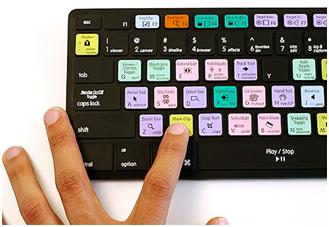Keyboard shortcuts are combinations of two or more keys that can be used to perform an action that normally would require repeatedly moving the mouse and would therefore take more time. Keyboard shortcuts can ease the way we interact with our PCs and we can increase speed, becoming more productive. It is true that each program has its own keyboard shortcuts, along with a number of combinations that are standard for Windows and generally used for most programs. As you work more and more with some programs, you will get to learn the shortcut sets.

Image source: http://blog.thetist.com/index.php/windows-keyboard-shortcuts/
Below you will be provided with a general set of keyboard commands available in various Windows applications, which will definitely save you some time.
F1 – Display help
Ctrl + C (or Ctrl + Insert) – Copy the selected object.
Ctrl + X – Cut the selected object.
Ctrl + V (or Shift + Insert) – Paste what you copied or cut using one of the two methods above
Ctrl + Z – Undo the last action
Ctrl + Y – Repeat last action
Delete (or Ctrl + D) – Delete object / selected object (s) and moves them to the Recycle Bin.
Shift + Delete – Delete the selected item permanently, without using Recycle Bin
F2 – Rename selected item
Ctrl + Right Arrow – When working with text moves to the beginning of the next word
Ctrl + Left Arrow – When working with text moves to the beginning of the previous word
Ctrl + Down Arrow – Move the cursor to the beginning of the next paragraph
Ctrl + Up Arrow – Move the cursor to the beginning of the previous paragraph
Ctrl + Shift and an arrow key – Select a block of text
Shift, used in combination with any arrow key – Select multiple items in a window or on the desktop, or select text in a document
Ctrl, used in combination with any arrow key + Spacebar – Select multiple individual items in a window or on the desktop
Ctrl + A – Select all the contents of a document or all objects in a folder or on the desktop
F3 – Search for files / folders
Alt + Enter – Show properties of the selected object
Alt + F4 – Close the active window or the current program
Alt + Spacebar – Open the shortcut menu of commands for the current window
Ctrl + F4 – or Ctrl + W – Close the current document (only in programs that allow simultaneous opening of several documents in the same window)
Alt + Tab – Switch between open windows
Ctrl + Alt + Tab – Use the arrow keys to switch between open windows
Windows logo + Tab – Switch between windows using Aero Flip 3-D (Windows 7)
Alt + Esc – Rotate through open programs in the order they were opened
F4 – Access the address bar in Windows Explorer
Shift + F10 – Display the shortcut menu for the selected object
Ctrl + Esc – Open the Start Menu
F10 – Activate the menu bar of the current program (if any)
Right Arrow – Open the next menu to the right of the current or submenu activated (if any)
LEFT ARROW – Open the next menu to the left, or close a submenu near the one already activated
F5 (or Ctrl + R) – reloads the current window
Alt + Up Arrow – Display the higher folder (parent folder) in Windows Explorer
Esc – Cancel what is currently running
Ctrl + Shift + Esc – Open Task Manager
Shift while inserting a CD – Avoid running it automatically (auto-run)
Left Alt + Shift – Changes the keyboard language when multiple keyboard languages are enabled
Ctrl + S – save the current document.
